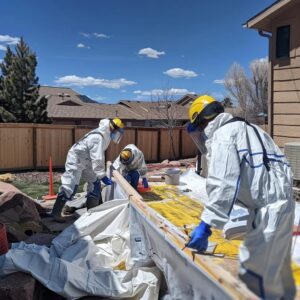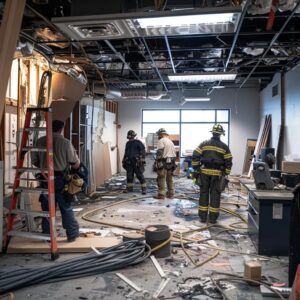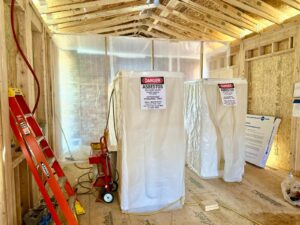The Hidden Dangers of Mold
Mold is a type of fungus that thrives in damp, warm environments. While it plays a vital role in nature by breaking down organic matter, it can become a significant problem when it invades our homes. Mold can go undetected for long periods, allowing it to grow and spread, posing serious health risks to you and your family. Knowing how to recognize mold detection signs is essential for maintaining a safe home environment.
Mold’s Impact on Health and Property
Exposure to mold can lead to a range of health issues, including respiratory problems, allergic reactions, and even more severe complications for those with weakened immune systems. The property damage caused by mold can be extensive, affecting structural integrity and leading to costly repairs. Professional assistance from a local restoration service can be vital in cases of severe infestation.
The Benefits of Early Detection
Identifying mold early can save homeowners significant time, money, and health issues. By taking proactive measures, you can mitigate the risks associated with mold, maintain a healthy living environment, and protect your investment in your home. Working with an expert Denver mold remediation team can help address mold issues promptly and thoroughly.
Understanding Mold and How It Grows
What Is Mold?
Mold is a fungus that reproduces by releasing spores into the air. There are many types of mold, but the most common indoor varieties include Aspergillus, Cladosporium, and Stachybotrys chartarum (often referred to as black mold). Understanding these varieties helps homeowners recognize the potential risks associated with mold exposure and better identify mold detection signs.
| Mold Type | Description | Features | How to Identify | Why It Appears | Common Spots |
| Aspergillus(household mold) | Common indoor mold that can appear in various colors. | Often powdery or dusty, colors range from white to green. | Appears as powdery patches in damp areas. | Grows due to excess moisture or poor ventilation. | Kitchens, bathrooms, HVAC systems, walls. |
| Cladosporium(wood mold) | Can grow in cooler areas, typically olive-green or black. | Velvety texture, can be dark green, brown, or black. | Often found in carpets, fabrics, and wooden surfaces. | Appears where there is high humidity and little sunlight. | Basements, closets, wood, and fabrics. |
| Stachybotrys(black mold) | Known as “black mold,” potentially toxic. | Slimy or sticky, often dark black or green. | Causes a musty smell; identified by sticky, black patches. | Requires constant moisture, often due to flooding or severe water damage. | Basements, drywall, ceilings, behind wallpaper. |
| Alternaria | Often found in damp or wet areas and is common outdoors. | Green, brown, or black with a fuzzy texture. | Appears in areas with persistent moisture, like sinks. | Grows in damp areas, often introduced from the outside. | Sinks, showers, windows, basements. |
Conditions That Encourage Mold Growth
Mold thrives in conditions where there is excess moisture, warmth, and organic material to feed on. Common culprits include:
| Condition | Explanation | Seasonal Influence |
| High Humidity | Mold thrives when indoor humidity exceeds 60%. Keeping humidity below this level is critical. | Common in summer and spring, when warmer weather increases moisture levels. |
| Water Leaks | Leaking roofs, pipes, or appliances create ideal conditions for mold, especially in hidden areas. | Year-round risk, but often worsened by heavy rain in spring and winter. |
| Poor Ventilation | Without proper air circulation, moisture gets trapped, allowing mold to grow in still, damp air. | Winter and fall, as homes are often closed up for warmth, limiting airflow. |
| Condensation | Condensation forms on cold surfaces, especially windows, walls, and pipes, providing moisture. | Mostly during winter, as colder temperatures increase condensation indoors. |
| Flooding or Water Intrusion | Flooded areas require extensive drying. Mold can begin to grow within 24-48 hours after water intrusion. | Typically, spring and fall when heavy rains or snowmelt can lead to flooding. |
| Organic Materials | Mold feeds on organic materials like wood, fabric, and drywall, especially when moist. | Not season-specific but is more likely in damp environments. |
Health Risks Associated with Mold Exposure
Mold can trigger various health issues, including:
- Allergies: Symptoms can include sneezing, runny nose, and itchy eyes.
- Asthma: Mold exposure can worsen asthma symptoms.
- Respiratory Issues: Prolonged exposure may lead to serious respiratory infections or lung complications.
In many cases, working with a mold removal company can be beneficial in fully addressing mold problems, especially for more severe infestations.
Identifying the Signs of Mold
Visible vs. Hidden Mold
Mold can be found in plain sight, such as on walls and ceilings, or hidden behind drywall, under carpets, or in insulation. Recognizing where mold can grow is crucial for effective detection.
General Indicators of Mold Presence
Homeowners should be vigilant for the following mold detection signs:
- Musty Smell: A persistent earthy odor often indicates mold growth.
- Water Stains: Look for brown or yellow discolorations on walls and ceilings.
- Peeling Paint: Bubbling or flaking paint can signify moisture problems.
Room-by-Room Breakdown
Mold can thrive in various areas of a home. Here are specific signs to look for in common spaces:
- Basements: Check for dampness, visible mold, and musty odors.
- Bathrooms: Look for black spots in grout, water stains, and peeling wallpaper.
- Attics: Inspect for stains on rafters and insulation, which may indicate leaks.
Preventative Steps to Reduce Mold Growth
Controlling Humidity Levels
Maintaining humidity levels below 60% is essential for mold prevention. Use a hygrometer to monitor levels and take steps to reduce humidity, such as:
- Using Dehumidifiers: Especially in basements and bathrooms.
- Ensuring Proper Ventilation: Open windows and use exhaust fans in high-moisture areas.
Prompt Repairs
Addressing leaks and water issues immediately can prevent mold growth. Check:
- Pipes and Appliances: Regularly inspect for leaks.
- Roofing: Ensure shingles are intact and gutters are clear.
Regular Cleaning Tips
Consistent cleaning can help prevent mold. Here are some effective techniques:
- Use Mold-Resistant Products: Choose mold-resistant paints and materials.
- Clean and Dry Damp Areas: Wipe down shower walls and dry any spills immediately.
- Wash Fabrics: Regularly wash shower curtains, towels, and carpets that may retain moisture.
Home Improvements
Consider investing in home improvements that reduce moisture and mold risks:
- Install Exhaust Fans: In kitchens and bathrooms to improve ventilation.
- Upgrade Insulation: Ensure adequate insulation in attics and basements to prevent condensation.
Dealing with Mold: Remediation Options
DIY Mold Removal
For minor mold problems, homeowners can often handle removal themselves. Here’s how:
- Use Protective Gear: Always wear gloves and a mask.
- Clean with Mild Detergent: Use soap and water for small areas, or a solution of vinegar and water.
- Ensure Proper Ventilation: While cleaning, keep the area well-ventilated.
Hiring a Mold Remediation Specialist
For larger infestations, hiring a professional is advisable. Here’s what to consider:
- Find Qualified Professionals: Look for certified mold remediation service providers or a reputable mold removal company.
- Cost Estimates: Understand the average costs, which can range from $500 to $6,000 depending on the severity of the issue.
Post-Remediation Inspection
After remediation, conduct a follow-up inspection to ensure the problem has been fully addressed. Use the checklist again to verify that no mold remains and that humidity levels are controlled.
Case Studies: Real Stories of Mold Detection and Remediation in Denver and Surrounding Areas
To better understand the impact of timely mold detection and effective remediation, here are some real-world examples from Denver and surrounding areas. Each case highlights common scenarios faced by homeowners in Colorado and underscores the importance of professional intervention by local mold remediation experts.
Case Study 1: Hidden Mold in a Lakewood Basement
- Overview: A homeowner in Lakewood, CO, began noticing a persistent musty odor in their basement. They had recently replaced the carpet but could not eliminate the smell. After weeks of unsuccessful attempts to address it, they reached out to a local mold removal company for an inspection.
- Discovery: During the inspection, the mold remediation specialist found significant basement mold (Aspergillus) growth beneath the baseboards and around the HVAC system. Moisture readings showed that the humidity levels in the basement were consistently high, creating an ideal environment for mold.
- Actions Taken: As local restoration service conducted a thorough cleaning and applied an antimicrobial treatment to the affected areas. We also recommended dehumidifiers to help control humidity.
- Outcome: The homeowner reported a complete resolution of the odor and was relieved to know that the mold was removed before it could cause more extensive structural or health issues. This case illustrates the importance of expert Denver mold remediation services that specialize in identifying hidden mold sources.
Conclusion: Staying Proactive Against Mold
Summary of Key Takeaways
Identifying mold early through regular inspections is crucial for maintaining a healthy living environment. The mold identification checklist is a valuable tool for homeowners, helping to catch issues before they escalate.
Encouragement for Routine Mold Checks
Homeowners should develop a routine for inspecting their homes for mold. Seasonal checks and immediate action after incidents can prevent serious health risks and property damage. Partnering with a trusted mold remediation service can be an added safeguard.








